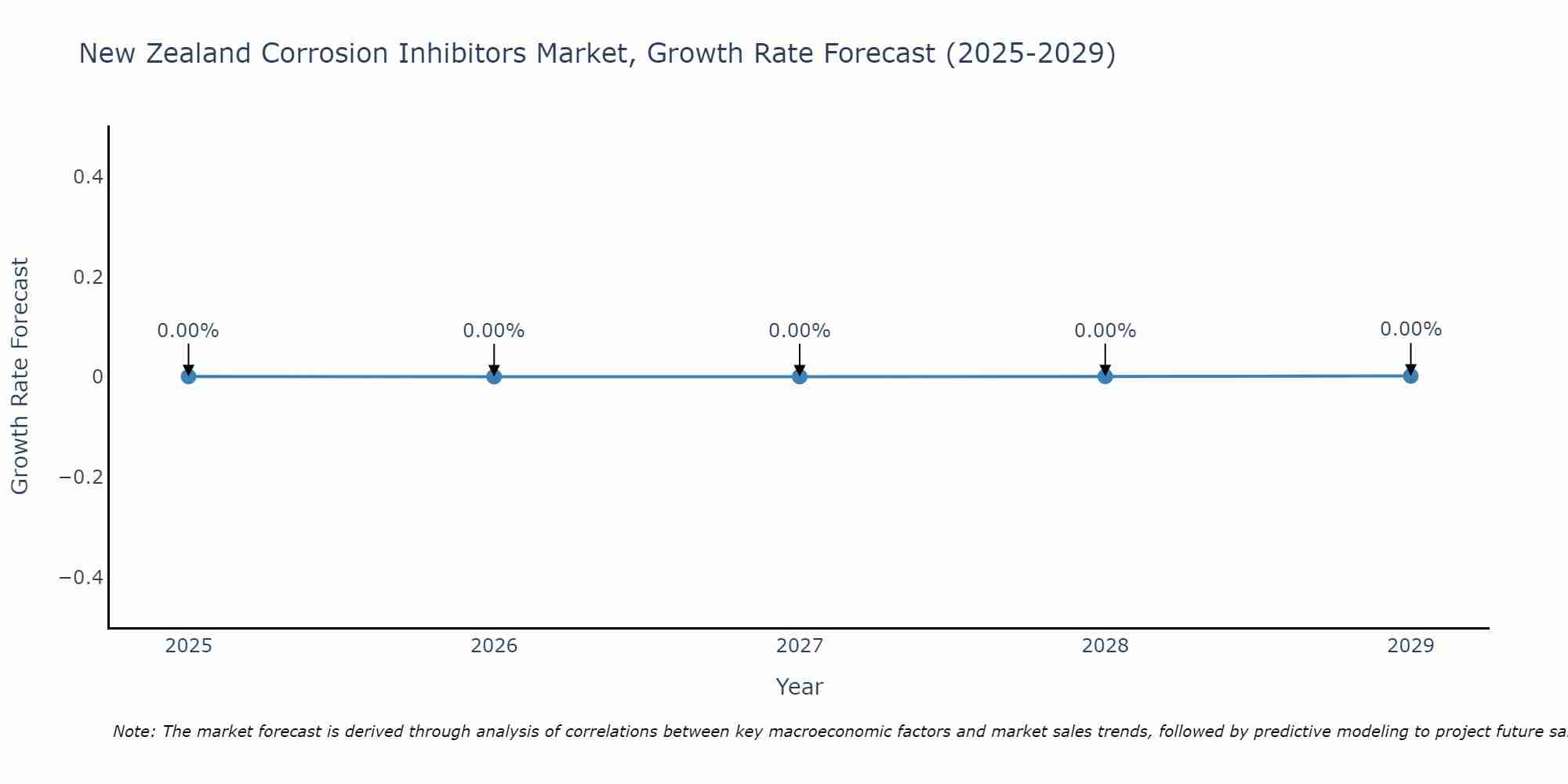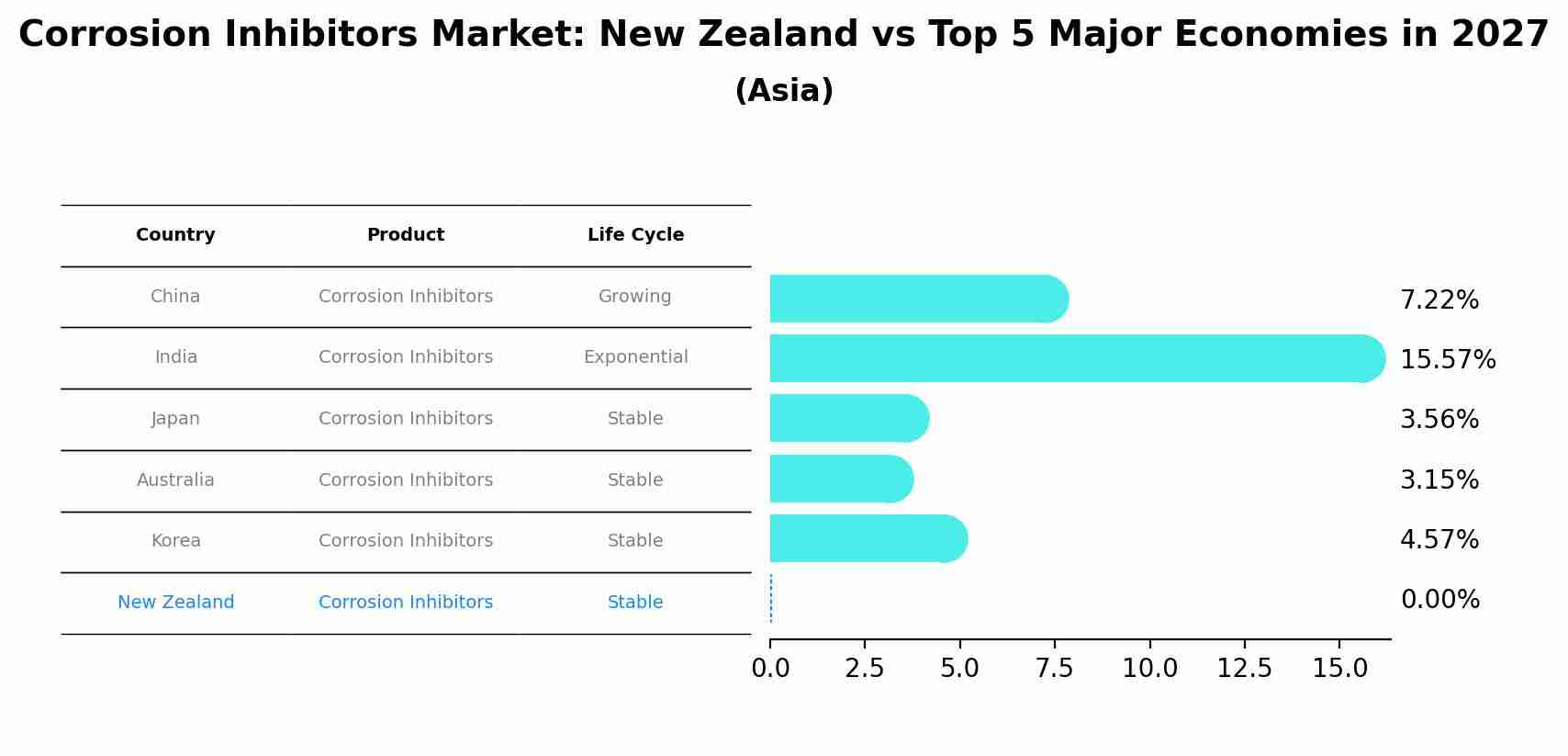New Zealand Corrosion Inhibitors Market (2025-2031) | Share, Industry, Growth, Revenue, Segmentation, Size, Analysis, Outlook, Forecast, Companies, Value & Trends
| Product Code: ETC4665984 | Publication Date: Nov 2023 | Updated Date: Apr 2025 | Product Type: Market Research Report | |
| Publisher: 6Wresearch | Author: Shubham Deep | No. of Pages: 60 | No. of Figures: 30 | No. of Tables: 5 |
New Zealand Corrosion Inhibitors Market Size Growth Rate
The New Zealand Corrosion Inhibitors Market is projected to witness mixed growth rate patterns during 2025 to 2029. From 0.00% in 2025, the growth rate steadily ascends to 0.00% in 2029.

Corrosion Inhibitors Market: New Zealand vs Top 5 Major Economies in 2027 (Asia)
New Zealand's Corrosion Inhibitors market is anticipated to experience a stable growth rate of 0.00% by 2027, reflecting trends observed in the largest economy China, followed by India, Japan, Australia and South Korea.

New Zealand Corrosion Inhibitors Market Overview
Corrosion inhibitors play a vital role in protecting metal surfaces from degradation caused by corrosion. In New Zealand, industries such as oil and gas, marine, and automotive rely on corrosion inhibitors to extend the lifespan of equipment and infrastructure.
Drivers of the market
The New Zealand corrosion inhibitors market is driven by the need to protect infrastructure and industrial equipment from corrosion. Key sectors such as oil and gas, water treatment, and construction rely heavily on corrosion inhibitors to extend the lifespan of their assets. Environmental regulations and the push for sustainable practices also encourage the development of eco-friendly corrosion inhibitors.
Challenges of the market
The New Zealand corrosion inhibitors market faces several challenges, primarily due to the country`s environmental regulations and the need for sustainable solutions. Companies must navigate stringent compliance requirements, which can increase operational costs. Additionally, the market is highly competitive with the presence of global and local players, leading to price pressures. Innovation is essential to develop eco-friendly inhibitors, yet this requires significant investment in research and development. Furthermore, the fluctuating prices of raw materials and the impact of economic conditions on key industries such as construction and marine also pose significant hurdles for market growth.
Government Policy of the market
Government policies in the corrosion inhibitors market aim to promote infrastructure durability, environmental protection, and safety standards. Regulations cover the use of corrosion inhibitors in various industries, product labeling, and environmental impact assessments. Additionally, support is provided for research into alternative, eco-friendly corrosion inhibitor technologies.
Key Highlights of the Report:
- New Zealand Corrosion Inhibitors Market Outlook
- Market Size of New Zealand Corrosion Inhibitors Market, 2024
- Forecast of New Zealand Corrosion Inhibitors Market, 2031
- Historical Data and Forecast of New Zealand Corrosion Inhibitors Revenues & Volume for the Period 2021-2031
- New Zealand Corrosion Inhibitors Market Trend Evolution
- New Zealand Corrosion Inhibitors Market Drivers and Challenges
- New Zealand Corrosion Inhibitors Price Trends
- New Zealand Corrosion Inhibitors Porter`s Five Forces
- New Zealand Corrosion Inhibitors Industry Life Cycle
- Historical Data and Forecast of New Zealand Corrosion Inhibitors Market Revenues & Volume By Product for the Period 2021-2031
- Historical Data and Forecast of New Zealand Corrosion Inhibitors Market Revenues & Volume By Organic for the Period 2021-2031
- Historical Data and Forecast of New Zealand Corrosion Inhibitors Market Revenues & Volume By Inorganic for the Period 2021-2031
- Historical Data and Forecast of New Zealand Corrosion Inhibitors Market Revenues & Volume By Type for the Period 2021-2031
- Historical Data and Forecast of New Zealand Corrosion Inhibitors Market Revenues & Volume By Water Based for the Period 2021-2031
- Historical Data and Forecast of New Zealand Corrosion Inhibitors Market Revenues & Volume By Oil Based for the Period 2021-2031
- Historical Data and Forecast of New Zealand Corrosion Inhibitors Market Revenues & Volume By End-use for the Period 2021-2031
- Historical Data and Forecast of New Zealand Corrosion Inhibitors Market Revenues & Volume By Power Generation for the Period 2021-2031
- Historical Data and Forecast of New Zealand Corrosion Inhibitors Market Revenues & Volume By Oil & Gas for the Period 2021-2031
- Historical Data and Forecast of New Zealand Corrosion Inhibitors Market Revenues & Volume By Paper & Pulp for the Period 2021-2031
- Historical Data and Forecast of New Zealand Corrosion Inhibitors Market Revenues & Volume By Metal Processing for the Period 2021-2031
- Historical Data and Forecast of New Zealand Corrosion Inhibitors Market Revenues & Volume By Chemical Processing for the Period 2021-2031
- Historical Data and Forecast of New Zealand Corrosion Inhibitors Market Revenues & Volume By Water Treatment for the Period 2021-2031
- Historical Data and Forecast of New Zealand Corrosion Inhibitors Market Revenues & Volume By Others for the Period 2021-2031
- New Zealand Corrosion Inhibitors Import Export Trade Statistics
- Market Opportunity Assessment By Product
- Market Opportunity Assessment By Type
- Market Opportunity Assessment By End-use
- New Zealand Corrosion Inhibitors Top Companies Market Share
- New Zealand Corrosion Inhibitors Competitive Benchmarking By Technical and Operational Parameters
- New Zealand Corrosion Inhibitors Company Profiles
- New Zealand Corrosion Inhibitors Key Strategic Recommendations
Frequently Asked Questions About the Market Study (FAQs):
1 Executive Summary |
2 Introduction |
2.1 Key Highlights of the Report |
2.2 Report Description |
2.3 Market Scope & Segmentation |
2.4 Research Methodology |
2.5 Assumptions |
3 New Zealand Corrosion Inhibitors Market Overview |
3.1 New Zealand Country Macro Economic Indicators |
3.2 New Zealand Corrosion Inhibitors Market Revenues & Volume, 2021 & 2031F |
3.3 New Zealand Corrosion Inhibitors Market - Industry Life Cycle |
3.4 New Zealand Corrosion Inhibitors Market - Porter's Five Forces |
3.5 New Zealand Corrosion Inhibitors Market Revenues & Volume Share, By Product, 2021 & 2031F |
3.6 New Zealand Corrosion Inhibitors Market Revenues & Volume Share, By Type, 2021 & 2031F |
3.7 New Zealand Corrosion Inhibitors Market Revenues & Volume Share, By End-use, 2021 & 2031F |
4 New Zealand Corrosion Inhibitors Market Dynamics |
4.1 Impact Analysis |
4.2 Market Drivers |
4.3 Market Restraints |
5 New Zealand Corrosion Inhibitors Market Trends |
6 New Zealand Corrosion Inhibitors Market Segmentations |
6.1 New Zealand Corrosion Inhibitors Market, By Product |
6.1.1 Overview and Analysis |
6.1.2 New Zealand Corrosion Inhibitors Market Revenues & Volume, By Organic, 2021-2031F |
6.1.3 New Zealand Corrosion Inhibitors Market Revenues & Volume, By Inorganic, 2021-2031F |
6.2 New Zealand Corrosion Inhibitors Market, By Type |
6.2.1 Overview and Analysis |
6.2.2 New Zealand Corrosion Inhibitors Market Revenues & Volume, By Water Based, 2021-2031F |
6.2.3 New Zealand Corrosion Inhibitors Market Revenues & Volume, By Oil Based, 2021-2031F |
6.3 New Zealand Corrosion Inhibitors Market, By End-use |
6.3.1 Overview and Analysis |
6.3.2 New Zealand Corrosion Inhibitors Market Revenues & Volume, By Power Generation, 2021-2031F |
6.3.3 New Zealand Corrosion Inhibitors Market Revenues & Volume, By Oil & Gas, 2021-2031F |
6.3.4 New Zealand Corrosion Inhibitors Market Revenues & Volume, By Paper & Pulp, 2021-2031F |
6.3.5 New Zealand Corrosion Inhibitors Market Revenues & Volume, By Metal Processing, 2021-2031F |
6.3.6 New Zealand Corrosion Inhibitors Market Revenues & Volume, By Chemical Processing, 2021-2031F |
6.3.7 New Zealand Corrosion Inhibitors Market Revenues & Volume, By Water Treatment, 2021-2031F |
7 New Zealand Corrosion Inhibitors Market Import-Export Trade Statistics |
7.1 New Zealand Corrosion Inhibitors Market Export to Major Countries |
7.2 New Zealand Corrosion Inhibitors Market Imports from Major Countries |
8 New Zealand Corrosion Inhibitors Market Key Performance Indicators |
9 New Zealand Corrosion Inhibitors Market - Opportunity Assessment |
9.1 New Zealand Corrosion Inhibitors Market Opportunity Assessment, By Product, 2021 & 2031F |
9.2 New Zealand Corrosion Inhibitors Market Opportunity Assessment, By Type, 2021 & 2031F |
9.3 New Zealand Corrosion Inhibitors Market Opportunity Assessment, By End-use, 2021 & 2031F |
10 New Zealand Corrosion Inhibitors Market - Competitive Landscape |
10.1 New Zealand Corrosion Inhibitors Market Revenue Share, By Companies, 2024 |
10.2 New Zealand Corrosion Inhibitors Market Competitive Benchmarking, By Operating and Technical Parameters |
11 Company Profiles |
12 Recommendations | 13 Disclaimer |
- Single User License$ 1,995
- Department License$ 2,400
- Site License$ 3,120
- Global License$ 3,795
Search
Related Reports
- ASEAN Bearings Market (2025-2031) | Strategy, Consumer Insights, Analysis, Investment Trends, Opportunities, Growth, Size, Share, Industry, Revenue, Segments, Value, Segmentation, Supply, Forecast, Restraints, Outlook, Competition, Drivers, Trends, Demand, Pricing Analysis, Competitive, Strategic Insights, Companies, Challenges
- Europe Flooring Market (2025-2031) | Outlook, Share, Industry, Trends, Forecast, Companies, Revenue, Size, Analysis, Growth & Value
- Saudi Arabia Manlift Market (2025-2031) | Outlook, Size, Growth, Trends, Companies, Industry, Revenue, Value, Share, Forecast & Analysis
- Uganda Excavator, Crane, and Wheel Loaders Market (2025-2031) | Strategy, Consumer Insights, Analysis, Investment Trends, Opportunities, Growth, Size, Share, Industry, Revenue, Segments, Value, Segmentation, Supply, Forecast, Restraints, Outlook, Competition, Drivers, Trends, Demand, Pricing Analysis, Competitive, Strategic Insights, Companies, Challenges
- Rwanda Excavator, Crane, and Wheel Loaders Market (2025-2031) | Strategy, Consumer Insights, Analysis, Investment Trends, Opportunities, Growth, Size, Share, Industry, Revenue, Segments, Value, Segmentation, Supply, Forecast, Restraints, Outlook, Competition, Drivers, Trends, Demand, Pricing Analysis, Competitive, Strategic Insights, Companies, Challenges
- Kenya Excavator, Crane, and Wheel Loaders Market (2025-2031) | Strategy, Consumer Insights, Analysis, Investment Trends, Opportunities, Growth, Size, Share, Industry, Revenue, Segments, Value, Segmentation, Supply, Forecast, Restraints, Outlook, Competition, Drivers, Trends, Demand, Pricing Analysis, Competitive, Strategic Insights, Companies, Challenges
- Angola Excavator, Crane, and Wheel Loaders Market (2025-2031) | Strategy, Consumer Insights, Analysis, Investment Trends, Opportunities, Growth, Size, Share, Industry, Revenue, Segments, Value, Segmentation, Supply, Forecast, Restraints, Outlook, Competition, Drivers, Trends, Demand, Pricing Analysis, Competitive, Strategic Insights, Companies, Challenges
- Israel Intelligent Transport System Market (2025-2031) | Strategy, Consumer Insights, Analysis, Investment Trends, Opportunities, Growth, Size, Share, Industry, Revenue, Segments, Value, Segmentation, Supply, Forecast, Restraints, Outlook, Competition, Drivers, Trends, Demand, Pricing Analysis, Competitive, Strategic Insights, Companies, Challenges
- Uganda Precast and Aggregate Market (2025-2031) | Strategy, Consumer Insights, Analysis, Investment Trends, Opportunities, Growth, Size, Share, Industry, Revenue, Segments, Value, Segmentation, Supply, Forecast, Restraints, Outlook, Competition, Drivers, Trends, Demand, Pricing Analysis, Competitive, Strategic Insights, Companies, Challenges
- Australia IT Asset Disposal Market (2025-2031) | Strategy, Consumer Insights, Analysis, Investment Trends, Opportunities, Growth, Size, Share, Industry, Revenue, Segments, Value, Segmentation, Supply, Forecast, Restraints, Outlook, Competition, Drivers, Trends, Demand, Pricing Analysis, Competitive, Strategic Insights, Companies, Challenges
Industry Events and Analyst Meet
Our Clients
Whitepaper
- Middle East & Africa Commercial Security Market Click here to view more.
- Middle East & Africa Fire Safety Systems & Equipment Market Click here to view more.
- GCC Drone Market Click here to view more.
- Middle East Lighting Fixture Market Click here to view more.
- GCC Physical & Perimeter Security Market Click here to view more.
6WResearch In News
- Doha a strategic location for EV manufacturing hub: IPA Qatar
- Demand for luxury TVs surging in the GCC, says Samsung
- Empowering Growth: The Thriving Journey of Bangladesh’s Cable Industry
- Demand for luxury TVs surging in the GCC, says Samsung
- Video call with a traditional healer? Once unthinkable, it’s now common in South Africa
- Intelligent Buildings To Smooth GCC’s Path To Net Zero













